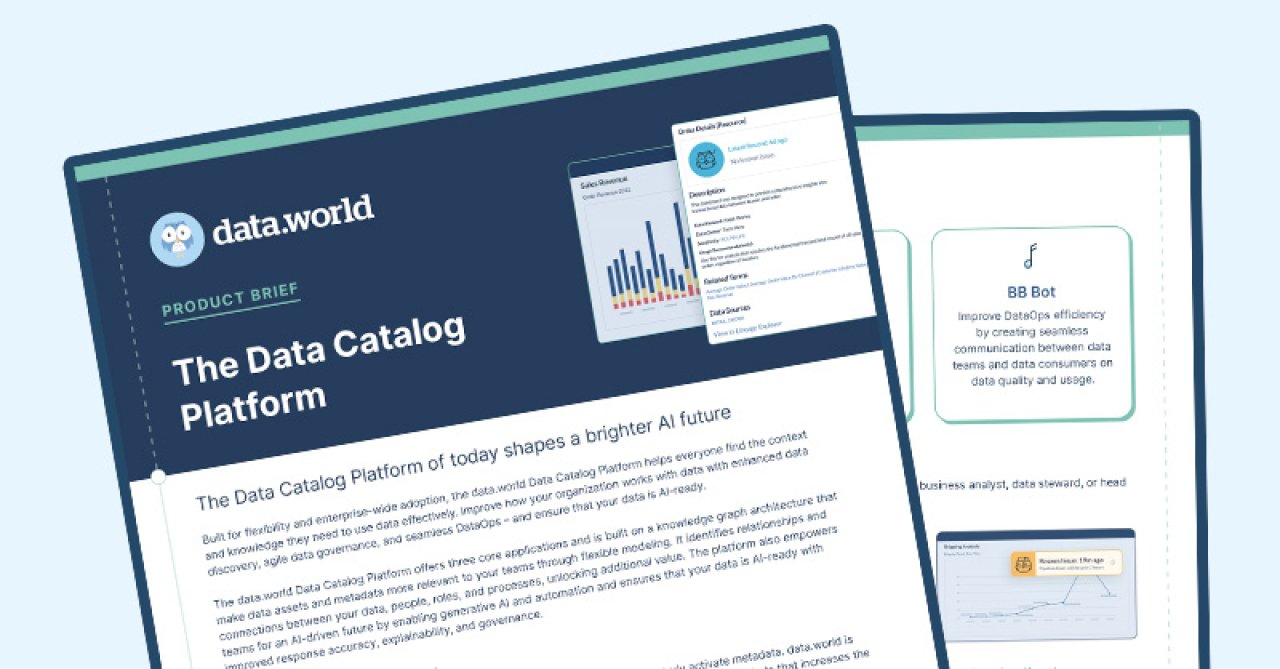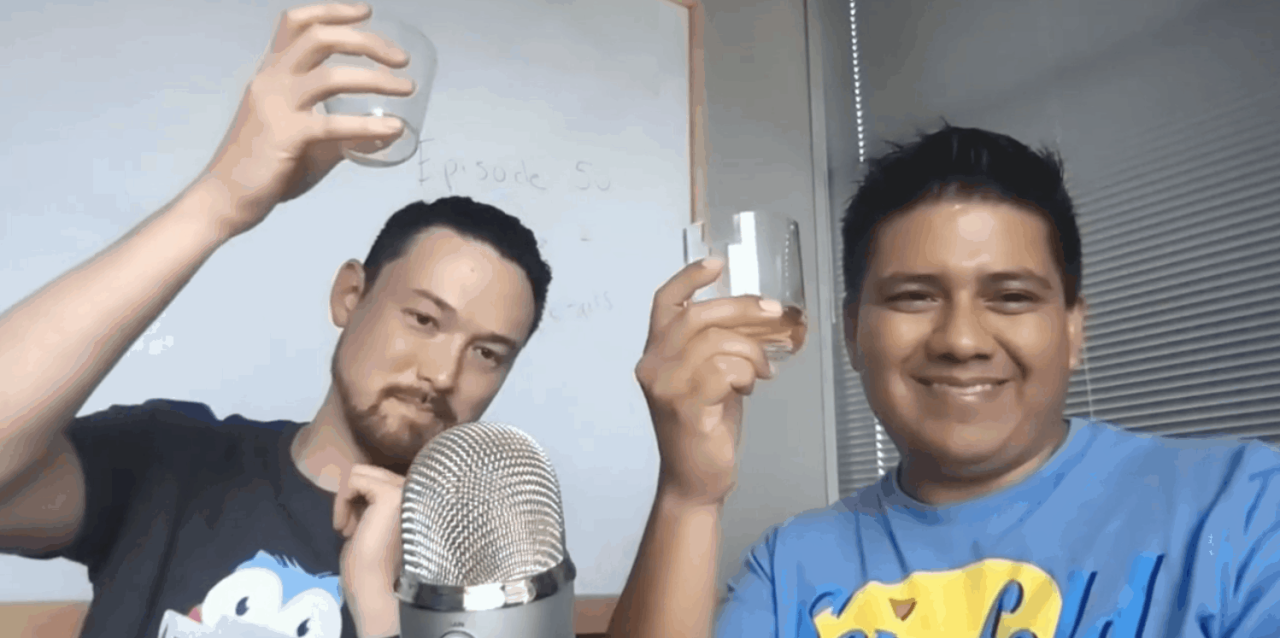























Jun 21, 2021

14 months, 50 episodes, and more than 100 cocktails. An honest, no-BS, non-salesy podcast about enterprise data management never sounded… or tasted so good.
Catalog and Cocktails debuted as a weekly happy hour-timed webinar in the very early days of the pandemic. An inauspicious time to launch any new venture. But the positive reviews following our very first episode on the future of data management led us to believe we had something really special.
We certainly were lucky to have two smart, thoughtful, and articulate hosts in Tim Gasper and Juan Sequeda, but we also made some interesting choices that I’m confident helped separate Catalog & Cocktails from other vendor-produced data management content.
1. No Self- or Vendor Promotion. We are very intentional about not featuring data.world’s or our guest’s products from the outset. Instead we created a safe space for data management ideas and concepts without the influence of sales and marketing. This allowed us to win the trust of our audience and grow our base of loyal listeners because they knew we weren’t trying to sell them anything.

2. Record Live with an Audience. Going live creates an air of immediacy and interest that recordings simply can’t capture. Our hosts draw so much energy from our live online audience (via Zoom). And when the live recording wraps, the hosts continue the conversation with the guests and viewers. This helped us build a global community.
3. Know your Audience and their Schedules. Timing is everything, and for Catalog & Cocktails, the best time was happy hour. Prime corporate webinar hours are between 10:00 am - 1:00 pm ET, and competing in that time slot would put us on par with everyone else. This needed to feel different, like an informal, approachable conversation among friends. And what better time to do that than Happy Hour? And of course that brought with it the added bonus of having a drink while you’re still on the clock.

4. Distribution Tech Matters. Webinar replays are a drag, so if you missed the show live, you flat out missed Catalog & Cocktails. About three episodes in, we decided to turn our live Zoom show into a weekly podcast to take advantage of the distribution model - easy access for anyone anywhere in the world. We have since embraced the podcast format that includes free flowing and wide-ranging conversations with interesting guests, and a consistent show flow from one 30-minute episode to the next, so listeners always know what to expect and when.
5. Be Authentic, Not Scripted. It’s the nature of marketing to put tight controls on their products. In this case, we stepped aside recognizing that no one knows the subject matter or the audience better than our hosts. Juan and Tim worked tirelessly to book great guests, write the outlines, and set the overall tone of the show. The marketing team, meanwhile, was responsible for promotion and production. Speaking of promotion, did I mention that Season 2 of Catalog & Cocktails begins on August 4?
6. Commit to a schedule. Hosting a weekly podcast is ambitious, especially when everyone involved has grueling day jobs. But missing a week is the quickest way to lose your audience. If you do have to skip for any reason (we paused for the George Floyd murder, the Capitol Insurrection, and the Texas snowstorm), try to re-run a popular episode in its place.
7. Don’t Be Afraid to Have Fun. Everything from our theme song, produced in-house by two of our co-founders, to our show logo, abstracts, and ads, to the show’s opening toast is intentional. While some episodes go deep on in-the-weeds topics like data mesh, identity graphs, and provenance, we always keep the conversation lively and entertaining. After all, listening to a podcast shouldn’t feel like work.

Click here to check out the podcast, and join the mailing list so you don’t miss the start of Season 2.

14 months, 50 episodes, and more than 100 cocktails. An honest, no-BS, non-salesy podcast about enterprise data management never sounded… or tasted so good.
Catalog and Cocktails debuted as a weekly happy hour-timed webinar in the very early days of the pandemic. An inauspicious time to launch any new venture. But the positive reviews following our very first episode on the future of data management led us to believe we had something really special.
We certainly were lucky to have two smart, thoughtful, and articulate hosts in Tim Gasper and Juan Sequeda, but we also made some interesting choices that I’m confident helped separate Catalog & Cocktails from other vendor-produced data management content.
1. No Self- or Vendor Promotion. We are very intentional about not featuring data.world’s or our guest’s products from the outset. Instead we created a safe space for data management ideas and concepts without the influence of sales and marketing. This allowed us to win the trust of our audience and grow our base of loyal listeners because they knew we weren’t trying to sell them anything.

2. Record Live with an Audience. Going live creates an air of immediacy and interest that recordings simply can’t capture. Our hosts draw so much energy from our live online audience (via Zoom). And when the live recording wraps, the hosts continue the conversation with the guests and viewers. This helped us build a global community.
3. Know your Audience and their Schedules. Timing is everything, and for Catalog & Cocktails, the best time was happy hour. Prime corporate webinar hours are between 10:00 am - 1:00 pm ET, and competing in that time slot would put us on par with everyone else. This needed to feel different, like an informal, approachable conversation among friends. And what better time to do that than Happy Hour? And of course that brought with it the added bonus of having a drink while you’re still on the clock.

4. Distribution Tech Matters. Webinar replays are a drag, so if you missed the show live, you flat out missed Catalog & Cocktails. About three episodes in, we decided to turn our live Zoom show into a weekly podcast to take advantage of the distribution model - easy access for anyone anywhere in the world. We have since embraced the podcast format that includes free flowing and wide-ranging conversations with interesting guests, and a consistent show flow from one 30-minute episode to the next, so listeners always know what to expect and when.
5. Be Authentic, Not Scripted. It’s the nature of marketing to put tight controls on their products. In this case, we stepped aside recognizing that no one knows the subject matter or the audience better than our hosts. Juan and Tim worked tirelessly to book great guests, write the outlines, and set the overall tone of the show. The marketing team, meanwhile, was responsible for promotion and production. Speaking of promotion, did I mention that Season 2 of Catalog & Cocktails begins on August 4?
6. Commit to a schedule. Hosting a weekly podcast is ambitious, especially when everyone involved has grueling day jobs. But missing a week is the quickest way to lose your audience. If you do have to skip for any reason (we paused for the George Floyd murder, the Capitol Insurrection, and the Texas snowstorm), try to re-run a popular episode in its place.
7. Don’t Be Afraid to Have Fun. Everything from our theme song, produced in-house by two of our co-founders, to our show logo, abstracts, and ads, to the show’s opening toast is intentional. While some episodes go deep on in-the-weeds topics like data mesh, identity graphs, and provenance, we always keep the conversation lively and entertaining. After all, listening to a podcast shouldn’t feel like work.

Click here to check out the podcast, and join the mailing list so you don’t miss the start of Season 2.
Get the best practices, insights, upcoming events & learn about data.world products.